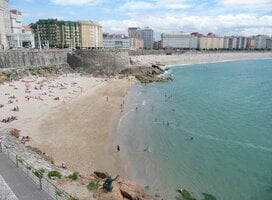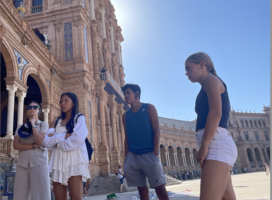Spanish Language Schools in Spain
The purpose of learning any language is to communicate and connect with others and better understand a culture different from your own. Spanish, being the second most spoken language in the world, is a good place to start if you want to be able to do that with as many people as possible. Not only is it spoken in 44 countries around the world, but it is also projected to be the first language of 50% of the U.S. population by 2050. Knowing Spanish can help you significantly without even leaving the country!
There are two types of Spanish – Latin American and European – both associated with distinct sets of vocabulary, accents, and cultural nuances. Learning Spanish in Spain will expose you to the “proper Spanish”, as Spaniards like to point out, and will allow you to immerse yourself in the centuries-old traditions that this pocket of Europe has to offer.
Read the guide on this page written by Go Overseas experts, just for you. Then choose a Spanish language program in Spain from the list below. You'll be well on your way to becoming a fluent Spanish speaker!
Choosing the right Spanish program for you depends on your purpose for learning the language and your personal goals for when you leave Spain. Think about whether you want to become fluent, learn vocabulary related to a specific field, have full cultural immersion, gain some extra language knowledge while traveling around.
Programs can range from a couple of weeks to a full academic year. The popularity of the language (it’s the second most learned in Europe) means that nearly any kind of program to suit a student’s needs will be available; you can take classes with other foreigners, be enrolled in a Spanish university, do an internship at a Spanish company, and more. Be aware that region will affect the vocabulary that you learn as well as the accent, and other languages can play a factor – i.e. many people in Barcelona also speak Catalán.
Program Types
- Language study & culture immersion programs: This option usually allows you to have a mix of classes with both foreigners and natives, depending on how much of a challenge you want, and the option of a homestay with a Spanish family for around-the-clock practice. A student whose goal is fluency, or at least conversational abilities, and a well rounded understanding and participation in the local culture would thrive in this type of program.
- Group classes: If you have no need to take specific university classes, or if you’re working while in Spain, take group classes with others who are in the same situation. This is better for someone trying to function in Spanish society on an everyday basis. Colloquial vocab and grammar is a bigger focus in these classes, and students learn from each other more than from a book because examples come from real life situations. Functionality is the main goal before fluency.
- Language study and internship combination programs: With big international cities like Madrid and Barcelona, gaining Spanish business knowledge is possible through language and internship programs. Go to language classes at night and use the words and phrases that you're learning in the office during the day. This option is best for those looking to gain a new dimension of experience in their field while being forced to learn the language and apply it quickly.
Cultural Immersion/Extracurricular Activities
Because Spain is not very large, it is easy to travel independently on weekends and see much of the country in a short time. For that reason, immersion-based programs, especially ones with a homestay option, are your best bet for learning as much about the country as possible. Choose programs that will get you involved with the local community and out exploring the area you're studying in. Spain has a lot of national holidays that are celebrated in full force with extra days off work, parades, huge festivals, and live music that will give you great insight to the local culture. Watch out for summer months when most of the country empties out for extended vacations.
Madrid
Madrid has been the country's capital since the 17th century and is easily the most "international" city in Spain; the stereotypically slower paced Spanish way of life is less relevant here, especially in the center where business people can be seen bustling about at all hours of the day. Over 80% of Madrid's inhabitants are Spaniards, with a majority of outsiders coming from Latin America.
Any sort of language program you can imagine will be offered here, and you will learn the most standard (and understandable) accent. The downside to studying in Spain's capital and biggest city is that there will be tourists abound and you can get away with using English as a crutch much easier than in other regions. Hit up the Golden Triangle: Madrid's triad of art museums made up of the Prado, Museo Nacional Centro de Arte Reina Sofia, and Museo Thyssen-Bornemisza.
Barcelona
Located on the coast of Spain's most northeastern autonomous community of Catalonia, Barcelona is considered the best beach city in the world. 95% of the population understands Catalán in some form, so Spanish learning could get a little confusing. It is also very touristy, like Madrid, but that means there's no shortage of things to do. See Gaudí’s La Sagrada Familia. Eat fresh caught seafood (not easily done in Madrid). Take a stroll on La Rambla, a popular street full of street artists, cafés, flower shops, and plenty of people watching.
Andalusia
Andalusia is the southern most autonomous community of Spain and home to several notable cities, like Seville and Granada. Because it is closest to Morocco, there is a notable Muslim influence. The accent used there is known to be more difficult to understand than in the central region of Spain – locals mumble and tend to not pronounce “S”s. This region may be of more interest to those studying fine arts or architecture because of the mixed cultural influences on both. Check out the Alhambra in Granada. Walk along the Guadalquivir River in Seville, and go to Feria de Abril if you’re there in April!
Why Learn Spanish In Spain?
Trying to learn and use a new language in a foreign country is going to be intimidating, but that’s what will push you to learn the quickest. The joy of Spanish is that once you learn the pronunciation rules (all vowels are pronounced the same), you can get away with faking it a bit and at least speak clearly while your comprehension and vocabulary grow. One could argue that you can gain both of those things by taking classes at your university in the U.S. or online, but being in an environment where Spanish is spoken around you at all times will push you to fluency and speaking with a native accent better than any American-born professor or computer will teach you a few hours per week.
Better yet, learning Spanish in Spain will allow you to live the Spanish way! Life is fast-paced in the U.S. Take advantage of the time you can dedicated to learning the Spanish language and culture, and RELAX. Enjoy a meal for two hours, stroll through the parks and chat with street artists, spend time with your adopted abuela in a homestay, and open your mind to a new way of communicating.
Highlights
- Check out the crowd: Spain is home to about 47.4 million people, 74% of which speak Castilian Spanish (Catalan, Galician, and Basque are the other commonly spoken languages, depending on region).
- Did you know..? Spain produces 44% of the world's olive oil. Pour it on!
- School's out, let's have some fun: Spain is known for its ability to enjoy life, and especially, for tapas. Find any café or restaurant with some outdoor seating to share a pitcher of sangria and a plate of queso manchego or jamón serrano with friends while people watching
- Wow others with an Idiom! "El que tiene boca se equivoca" = He who has a mouth makes mistakes, which we'd say as, "everyone makes mistakes."
You don’t need a visa if your stay is less than 90 days. Beyond that, you should check with the Spanish consulate nearest you, but can apply 3 months before departure. Processing can take up to 2 months, so apply ASAP within the 3-month timeline. Age of participants varies depending on program, generally college students and young working adults, especially at group classes. Programs are available at all levels, so no prior knowledge of Spanish is necessary, but it would definitely make it easier to get around upon arriving.
As a general rule of thumb, Europe is going to be more expensive for U.S. travelers due to exchange rates. Programs with fewer "perks", like pre-planned excursions, will be more affordable; if you're on a budget, look for those bare bones programs that only offer classes and help finding a place to live.
You cannot legally work in Spain without a proper work visa, but some students offer private English lessons as a way to make some cash while traveling the country. The best ways to save money are to avoid the biggest cities, where prices are inflated for tourists; smaller beach towns offer lower prices and fresher food. Northern Spain is great for free outdoor activities, like hiking. Shopping locally is your best bet to not only save money but get you interacting with locals, as well.
Scholarships
- Program-specific scholarships: Many of the larger study abroad companies offer scholarships exclusively to their participants, which increases chances of getting one since the applicant pool is smaller. They tend to be smaller amounts ($250-$1,500), but help to offset costs, like transportation.
- University-specific scholarships: Either from your home university or the university where you may be studying in Spain, scholarships are offered for language and cultural studies. These can range from a couple hundred dollars to the cost of your program's tuition.
- Go Overseas “65 Study Abroad Grants and Scholarships”













